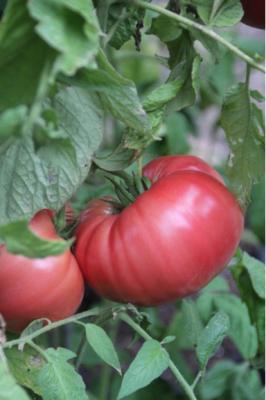FOR IMMEDIATE RELEASE
URBANA, Ill. – Gardeners across Illinois have been climbing the walls waiting for the wet spring to let up so they can finally transplant all those fantastic warm-season crops. That day is finally drawing near!
When dreaming about the bounty of warm-season fruits and veggies, one jewel of summer stands out in University of Illinois Extension Horticulture Educator Austin Little’s mind. “The coveted and celebrated heirloom tomato varieties, which start ripening around late June, are a very attractive choice for gardeners,” he says. “They’re desirable not only for their superior flavor and texture, but also to avoid the shocking sticker price at the market, at $6 a pound!”
To Little, those are good reasons to try growing heirloom varieties such as Cherokee Purple or Black Krim in the home garden. Save a little cash while impressing the neighbors!
Popular hybridized tomato varieties such as Big Boy and Beef Steak tomatoes result from years of controlled breeding (hybridizing) for specific traits such as disease resistance, vigor, and yield. Unfortunately, the seeds are genetically unpredictable. You can’t be sure what kind of fruit they will produce, if they produce fruit at all.
On the other hand, heirloom varieties have been carefully selected and propagated for 50 years or more, often pre-WWII. Heirloom varieties are open-pollinated with traits that are generally stable from one generation to the next, although yield and size are more unpredictable.
“While heirloom tomatoes are a worthy project, they require a bit more attention than the popular hybrid tomato varieties, and there are a few specific practices that can help ensure a successful heirloom tomato yield,” Little says.
The most limiting factor of successful heirloom tomato production is disease, so reducing the chances for disease is key. One of the most effective tricks for improving heirloom performance is grafting a vegetative heirloom cutting onto a disease-resistant hybrid rootstock. With this practice, the plant gets the resistance traits of a hybrid while maintaining the unique qualities of the heirloom fruit. “Grafting can improve yields up to a whopping 60%,” Little says.
Heirloom tomatoes are often vigorous indeterminate growers that need to be pruned more often. Pruning or pinching back “suckers” that arise from axils (angles between a leaf and the main stem) is important. Removing suckers provides better air circulation, which helps prevent foliar diseases. Another way to improve air circulation is to give heirlooms lots of space, about 1 foot between plants and 4 feet between rows.
Heirloom tomatoes are susceptible to fungal and bacterial infections; keeping the foliage dry helps to prevent these diseases. Avoid water splashing up onto foliage by using drip tape and mulch in the garden. These practices also help to get a more thorough watering to the roots. Of course, staking and caging will also help to keep the foliage off the ground.
As for fertilizing these historical varieties, sometimes less is more. Soil testing is a good place to start. Generally, tomatoes benefit from a complete NPK fertilizer with a rating of around 5-5-5 applied at planting. The same can be achieved by top dressing with compost in the spring or fall, with or without the addition of an organic fertilizer if you’re an organic heirloom grower. One thing to keep in mind is that once tomatoes set flowers, more nitrogen will produce bushy vegetative growth and reduce fruit quality.
“The most important factor to manage for heirloom tomatoes is reduction of disease pressure. Some of the best practices for improving yield are grafting, staking, controlling water, ensuring the plants can ‘breathe,’ and feeding the soil,” Little says. “By implementing these practices in your next heirloom adventure, you’ll soon be enjoying a nice Caprese salad with big juicy slices of Cherokee Purple tomatoes this summer!”
Source/news writer: Austin Little, 618-687-1727, little84@illinois.edu
Source: Richard A. Little, Extension Educator, Horticulture, little84@illinois.edu
Pull date: May 12, 2020
